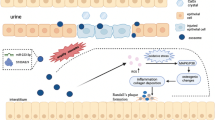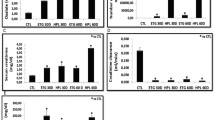Abstract
Kidney stone disease is associated with renal fibrosis by the unclear mechanisms. We hypothesized that calcium oxalate (CaOx), a major crystalline component of kidney stones, could induce secretion of fibrotic factors from macrophages leading to “epithelial mesenchymal transition/transdifferentiation” (EMT) of renal tubular cells. Western blot analysis revealed an increased level of vimentin (mesenchymal marker) but decreased levels of E-cadherin and cytokeratin (epithelial markers) in MDCK cells treated with “secreted products from CaOx-exposed macrophages” (CaOx-M-Sup). Immunofluorescence study confirmed the increased level of vimentin and decreased level of cytokeratin, and also revealed the increased level of fibronectin (another mesenchymal marker). The data also showed decreased levels and disorganization of F-actin (cytoskeletal marker) and zonula occludens-1 (ZO-1) (tight junction marker) induced by CaOx-M-Sup. ELISA demonstrated the increased level of transforming growth factor-β1 (TGF-β1), the well-defined EMT inducer, in CaOx-M-Sup. Downstream signaling of TGF-β1 was involved as demonstrated by the decreased level of RhoA. Interestingly, pretreatment with a proteasome inhibitor (MG132) could restore RhoA to its basal level, most likely through ubiquitin-proteasome pathway (UPP). Moreover, MG132 successfully sustained cytoskeletal assembly and tight junction, and could prevent the cells from EMT. Altogether, these data demonstrate for the first time that CaOx-M-Sup could induce EMT in renal tubular cells by TGF-β1 signaling cascade via RhoA and UPP. This may be, at least in part, the underlying mechanism for renal fibrosis in kidney stone disease.



Similar content being viewed by others
References
Saucier, N. A., Sinha, M. K., Liang, K. V., Krambeck, A. E., Weaver, A. L., Bergstralh, E. J., et al. (2010). Risk factors for CKD in persons with kidney stones: A case–control study in Olmsted County, Minnesota. American Journal of Kidney Diseases, 55, 61–68.
Iseki, K. (2008). Chronic kidney disease in Japan. Internal Medicine, 47, 681–689.
Iwano, M. (2010). EMT and TGF-beta in renal fibrosis. Frontiers in Bioscience (Scholar edition), 2, 229–238.
Rastaldi, M. P., Ferrario, F., Giardino, L., Dell’Antonio, G., Grillo, C., Grillo, P., et al. (2002). Epithelial–mesenchymal transition of tubular epithelial cells in human renal biopsies. Kidney International, 62, 137–146.
Zeisberg, M., & Neilson, E. G. (2009). Biomarkers for epithelial–mesenchymal transitions. Journal of Clinical Investigation, 119, 1429–1437.
Liu, Y. (2004). Epithelial to mesenchymal transition in renal fibrogenesis: Pathologic significance, molecular mechanism, and therapeutic intervention. Journal of the American Society of Nephrology, 15, 1–12.
Xu, J., Lamouille, S., & Derynck, R. (2009). TGF-beta-induced epithelial to mesenchymal transition. Cell Research, 19, 156–172.
Iwano, M., Plieth, D., Danoff, T. M., Xue, C., Okada, H., & Neilson, E. G. (2002). Evidence that fibroblasts derive from epithelium during tissue fibrosis. Journal of Clinical Investigation, 110, 341–350.
Garcia-Sanchez, O., Lopez-Hernandez, F. J., & Lopez-Novoa, J. M. (2010). An integrative view on the role of TGF-beta in the progressive tubular deletion associated with chronic kidney disease. Kidney International, 77, 950–955.
Ivanova, L., Butt, M. J., & Matsell, D. G. (2008). Mesenchymal transition in kidney collecting duct epithelial cells. American Journal of Physiology-Renal Physiology, 294, F1238–F1248.
de Water, R., Noordermeer, C., van der Kwast, T. H., Nizze, H., Boeve, E. R., Kok, D. J., et al. (1999). Calcium oxalate nephrolithiasis: Effect of renal crystal deposition on the cellular composition of the renal interstitium. American Journal of Kidney Diseases, 33, 761–771.
de Water, R., Noordermeer, C., Houtsmuller, A. B., Nigg, A. L., Stijnen, T., Schroder, F. H., et al. (2000). Role of macrophages in nephrolithiasis in rats: An analysis of the renal interstitium. American Journal of Kidney Diseases, 36, 615–625.
de Water, R., Leenen, P. J., Noordermeer, C., Nigg, A. L., Houtsmuller, A. B., Kok, D. J., et al. (2001). Cytokine production induced by binding and processing of calcium oxalate crystals in cultured macrophages. American Journal of Kidney Diseases, 38, 331–338.
Leonard, M., Ryan, M. P., Watson, A. J., Schramek, H., & Healy, E. (1999). Role of MAP kinase pathways in mediating IL-6 production in human primary mesangial and proximal tubular cells. Kidney International, 56, 1366–1377.
Sean, E. K., & Cockwell, P. (2005). Macrophages and progressive tubulointerstitial disease. Kidney International, 68, 437–455.
Wilson, H. M., Walbaum, D., & Rees, A. J. (2004). Macrophages and the kidney. Current Opinion in Nephrology and Hypertension, 13, 285–290.
Sintiprungrat, K., Singhto, N., Sinchaikul, S., Chen, S. T., & Thongboonkerd, V. (2010). Alterations in cellular proteome and secretome upon differentiation from monocyte to macrophage by treatment with phorbol myristate acetate: Insights into biological processes. Journal of Proteomics, 73, 602–618.
Semangoen, T., Sinchaikul, S., Chen, S. T., & Thongboonkerd, V. (2008). Proteomic analysis of altered proteins in distal renal tubular cells in response to calcium oxalate monohydrate crystal adhesion: Implications for kidney stone disease. Proteomics Clinical Applications, 2, 1099–1109.
Thongboonkerd, V., Semangoen, T., Sinchaikul, S., & Chen, S. T. (2008). Proteomic analysis of calcium oxalate monohydrate crystal-induced cytotoxicity in distal renal tubular cells. Journal of Proteome Research, 7, 4689–4700.
Kinsey, G. R., Li, L., & Okusa, M. D. (2008). Inflammation in acute kidney injury. Nephron Experimental Nephrology, 109, e102–e107.
Coe, F. L., Evan, A., & Worcester, E. (2005). Kidney stone disease. Journal of Clinical Investigation, 115, 2598–2608.
Das, S., Becker, B. N., Hoffmann, F. M., & Mertz, J. E. (2009). Complete reversal of epithelial to mesenchymal transition requires inhibition of both ZEB expression and the Rho pathway. BMC Cell Biology, 10, 94.
Mathias, R. A., Wang, B., Ji, H., Kapp, E. A., Moritz, R. L., Zhu, H. J., et al. (2009). Secretome-based proteomic profiling of Ras-transformed MDCK cells reveals extracellular modulators of epithelial–mesenchymal transition. Journal of Proteome Research, 8, 2827–2837.
Hills, C. E., & Squires, P. E. (2010). TGF-beta1-induced epithelial-to-mesenchymal transition and therapeutic intervention in diabetic nephropathy. American Journal of Nephrology, 31, 68–74.
Campanaro, S., Picelli, S., Torregrossa, R., Colluto, L., Ceol, M., Del Prete, D., et al. (2007). Genes involved in TGF beta1-driven epithelial–mesenchymal transition of renal epithelial cells are topologically related in the human interactome map. BMC Genomics, 8, 383.
Bishop, A. L., & Hall, A. (2000). Rho GTPases and their effector proteins. Biochemical Journal, 348(2), 241–255.
Hutchison, N., Hendry, B. M., & Sharpe, C. C. (2009). Rho isoforms have distinct and specific functions in the process of epithelial to mesenchymal transition in renal proximal tubular cells. Cellular Signalling, 21, 1522–1531.
Bhowmick, N. A., Ghiassi, M., Bakin, A., Aakre, M., Lundquist, C. A., Engel, M. E., et al. (2001). Transforming growth factor-beta1 mediates epithelial to mesenchymal transdifferentiation through a RhoA-dependent mechanism. Molecular Biology of the Cell, 12, 27–36.
Fukata, M., Nakagawa, M., & Kaibuchi, K. (2003). Roles of Rho-family GTPases in cell polarisation and directional migration. Current Opinion in Cell Biology, 15, 590–597.
Ozdamar, B., Bose, R., Barrios-Rodiles, M., Wang, H. R., Zhang, Y., & Wrana, J. L. (2005). Regulation of the polarity protein Par6 by TGFbeta receptors controls epithelial cell plasticity. Science, 307, 1603–1609.
Wang, H. R., Zhang, Y., Ozdamar, B., Ogunjimi, A. A., Alexandrova, E., Thomsen, G. H., et al. (2003). Regulation of cell polarity and protrusion formation by targeting RhoA for degradation. Science, 302, 1775–1779.
Pellegrin, S., & Mellor, H. (2007). Actin stress fibres. Journal of Cell Science, 120, 3491–3499.
Gunaratne, A., Thai, B. L., & Di Guglielmo, G. M. (2013). Atypical protein kinase C phosphorylates Par6 and facilitates transforming growth factor beta-induced epithelial-to-mesenchymal transition. Molecular and Cellular Biology, 33, 874–886.
Rodriguez-Iturbe, B., & Garcia, G. G. (2010). The role of tubulointerstitial inflammation in the progression of chronic renal failure. Nephron Clinical Practice, 116, c81–c88.
Xie, P., Sun, L., Nayak, B., Haruna, Y., Liu, F. Y., Kashihara, N., et al. (2009). C/EBP-beta modulates transcription of tubulointerstitial nephritis antigen in obstructive uropathy. Journal of the American Society of Nephrology, 20, 807–819.
Tan, T. K., Zheng, G., Hsu, T. T., Wang, Y., Lee, V. W., Tian, X., et al. (2010). Macrophage matrix metalloproteinase-9 mediates epithelial–mesenchymal transition in vitro in murine renal tubular cells. American Journal of Pathology, 176, 1256–1270.
Nelson, W. J., & Nusse, R. (2004). Convergence of Wnt, beta-catenin, and cadherin pathways. Science, 303, 1483–1487.
Zavadil, J., Cermak, L., Soto-Nieves, N., & Bottinger, E. P. (2004). Integration of TGF-beta/Smad and Jagged1/Notch signalling in epithelial-to-mesenchymal transition. EMBO Journal, 23, 1155–1165.
Kattla, J. J., Carew, R. M., Heljic, M., Godson, C., & Brazil, D. P. (2008). Protein kinase B/Akt activity is involved in renal TGF-beta1-driven epithelial–mesenchymal transition in vitro and in vivo. American Journal of Physiology-Renal Physiology, 295, F215–F225.
Liu, Y. (2006). Renal fibrosis: New insights into the pathogenesis and therapeutics. Kidney International, 69, 213–217.
Saad, S., Stanners, S. R., Yong, R., Tang, O., & Pollock, C. A. (2010). Notch mediated epithelial to mesenchymal transformation is associated with increased expression of the Snail transcription factor. International Journal of Biochemistry & Cell Biology, 42, 1115–1122.
Acknowledgments
We thank Ms. Paleerath Peerapen for her technical assistance. This study was supported by The Thailand Research Fund (RTA5380005 and TRG5480005), Office of the Higher Education Commission and Mahidol University under the National Research Universities Initiative, and Faculty of Medicine Siriraj Hospital. KS is supported by the Royal Golden Jubilee PhD Program, whereas VT is also supported by the “Chalermphrakiat” Grant, Faculty of Medicine Siriraj Hospital.
Author information
Authors and Affiliations
Corresponding author
Rights and permissions
About this article
Cite this article
Kanlaya, R., Sintiprungrat, K. & Thongboonkerd, V. Secreted Products of Macrophages Exposed to Calcium Oxalate Crystals Induce Epithelial Mesenchymal Transition of Renal Tubular Cells via RhoA-Dependent TGF-β1 Pathway. Cell Biochem Biophys 67, 1207–1215 (2013). https://doi.org/10.1007/s12013-013-9639-z
Published:
Issue Date:
DOI: https://doi.org/10.1007/s12013-013-9639-z




